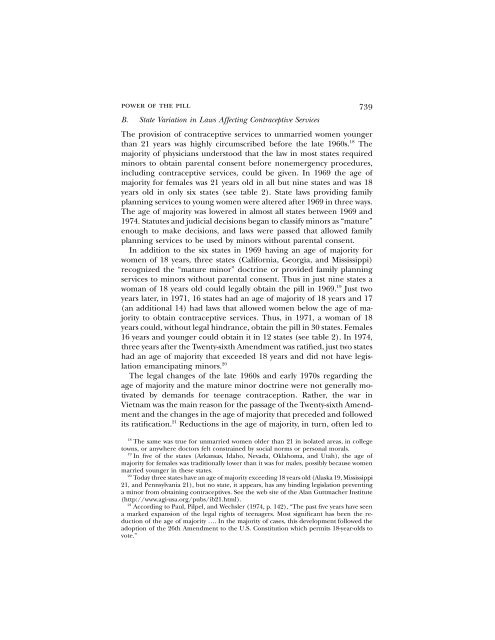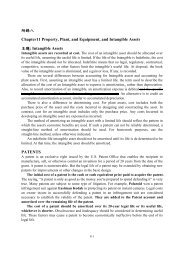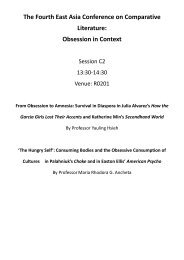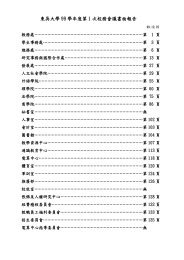The Power of the Pill: Oral Contraceptives and Women's ... - Mail
The Power of the Pill: Oral Contraceptives and Women's ... - Mail
The Power of the Pill: Oral Contraceptives and Women's ... - Mail
You also want an ePaper? Increase the reach of your titles
YUMPU automatically turns print PDFs into web optimized ePapers that Google loves.
power <strong>of</strong> <strong>the</strong> pill 739<br />
B. State Variation in Laws Affecting Contraceptive Services<br />
<strong>The</strong> provision <strong>of</strong> contraceptive services to unmarried women younger<br />
than 21 years was highly circumscribed before <strong>the</strong> late 1960s. 18 <strong>The</strong><br />
majority <strong>of</strong> physicians understood that <strong>the</strong> law in most states required<br />
minors to obtain parental consent before nonemergency procedures,<br />
including contraceptive services, could be given. In 1969 <strong>the</strong> age <strong>of</strong><br />
majority for females was 21 years old in all but nine states <strong>and</strong> was 18<br />
years old in only six states (see table 2). State laws providing family<br />
planning services to young women were altered after 1969 in three ways.<br />
<strong>The</strong> age <strong>of</strong> majority was lowered in almost all states between 1969 <strong>and</strong><br />
1974. Statutes <strong>and</strong> judicial decisions began to classify minors as “mature”<br />
enough to make decisions, <strong>and</strong> laws were passed that allowed family<br />
planning services to be used by minors without parental consent.<br />
In addition to <strong>the</strong> six states in 1969 having an age <strong>of</strong> majority for<br />
women <strong>of</strong> 18 years, three states (California, Georgia, <strong>and</strong> Mississippi)<br />
recognized <strong>the</strong> “mature minor” doctrine or provided family planning<br />
services to minors without parental consent. Thus in just nine states a<br />
woman <strong>of</strong> 18 years old could legally obtain <strong>the</strong> pill in 1969. 19 Just two<br />
years later, in 1971, 16 states had an age <strong>of</strong> majority <strong>of</strong> 18 years <strong>and</strong> 17<br />
(an additional 14) had laws that allowed women below <strong>the</strong> age <strong>of</strong> majority<br />
to obtain contraceptive services. Thus, in 1971, a woman <strong>of</strong> 18<br />
years could, without legal hindrance, obtain <strong>the</strong> pill in 30 states. Females<br />
16 years <strong>and</strong> younger could obtain it in 12 states (see table 2). In 1974,<br />
three years after <strong>the</strong> Twenty-sixth Amendment was ratified, just two states<br />
had an age <strong>of</strong> majority that exceeded 18 years <strong>and</strong> did not have legislation<br />
emancipating minors. 20<br />
<strong>The</strong> legal changes <strong>of</strong> <strong>the</strong> late 1960s <strong>and</strong> early 1970s regarding <strong>the</strong><br />
age <strong>of</strong> majority <strong>and</strong> <strong>the</strong> mature minor doctrine were not generally motivated<br />
by dem<strong>and</strong>s for teenage contraception. Ra<strong>the</strong>r, <strong>the</strong> war in<br />
Vietnam was <strong>the</strong> main reason for <strong>the</strong> passage <strong>of</strong> <strong>the</strong> Twenty-sixth Amendment<br />
<strong>and</strong> <strong>the</strong> changes in <strong>the</strong> age <strong>of</strong> majority that preceded <strong>and</strong> followed<br />
its ratification. 21 Reductions in <strong>the</strong> age <strong>of</strong> majority, in turn, <strong>of</strong>ten led to<br />
18<br />
<strong>The</strong> same was true for unmarried women older than 21 in isolated areas, in college<br />
towns, or anywhere doctors felt constrained by social norms or personal morals.<br />
19<br />
In five <strong>of</strong> <strong>the</strong> states (Arkansas, Idaho, Nevada, Oklahoma, <strong>and</strong> Utah), <strong>the</strong> age <strong>of</strong><br />
majority for females was traditionally lower than it was for males, possibly because women<br />
married younger in <strong>the</strong>se states.<br />
20<br />
Today three states have an age <strong>of</strong> majority exceeding 18 years old (Alaska 19, Mississippi<br />
21, <strong>and</strong> Pennsylvania 21), but no state, it appears, has any binding legislation preventing<br />
a minor from obtaining contraceptives. See <strong>the</strong> web site <strong>of</strong> <strong>the</strong> Alan Guttmacher Institute<br />
(http://www.agi-usa.org/pubs/ib21.html).<br />
21<br />
According to Paul, Pilpel, <strong>and</strong> Wechsler (1974, p. 142), “<strong>The</strong> past five years have seen<br />
a marked expansion <strong>of</strong> <strong>the</strong> legal rights <strong>of</strong> teenagers. Most significant has been <strong>the</strong> reduction<br />
<strong>of</strong> <strong>the</strong> age <strong>of</strong> majority …. In <strong>the</strong> majority <strong>of</strong> cases, this development followed <strong>the</strong><br />
adoption <strong>of</strong> <strong>the</strong> 26th Amendment to <strong>the</strong> U.S. Constitution which permits 18-year-olds to<br />
vote.”















